Timeline
More from year 1967
Spread the love! If you like what you are seeing, share it on social networks and let others know about The Paul McCartney Project.
About
Saturday morning, I had my pocket money. I used to go down to this big department store called Lewis’s, get the record that I’d been saving up for, then get on the bus and unwrap it. Then I had half an hour to look at it… and read the sleeve note and look at the pictures and everything. We designed Sgt. Pepper with that in mind. The person who’s just been to his version of Lewis’s, he’s got that half hour so we’ll give him masses. He can look at this one for months!
Paul McCartney – From the “Sgt. Pepper’s Lonely Hearts Club Band” box set, 2017
The Fool’s concept for the “Sgt. Pepper” cover
In 1966, The Beatles struggled to come up with a title for their next album and only decided on “Revolver” after several brainstorming sessions at the end of the recording sessions. However, in 1967, they took a different approach for their next album. The concept was for The Beatles to adopt the persona of a fictional band, “Sgt. Pepper’s Lonely Hearts Club Band.” The name of the fictional band became the album title, and they started working on designing the packaging for the album almost two months before the end of the recording sessions.
Initially, The Beatles had approached The Fool, a Dutch design collective and band in the psychedelic style of art, to come up with the artwork for the album. Marijke Koger, a member of the collective, presented a rough concept that initially excited The Beatles. However, they discussed it with their friend and art dealer, Robert Fraser, who discouraged them from using the psychedelic artwork by Marijke Koger and instead suggested that they approach the pop artists Peter Blake and his then-wife Jann Haworth for the album artwork.
[The Beatles] invited us to the recording session party for “A Day in the Life” at the EMI studio on Abbey Road on February 10, 1967, which was to be released as a single June 1st. I danced around with sparkles and blowing bubbles enjoying myself very much, it was great fun. I have never been much of talker and Simon [Posthuma] with his “gift of the gab” was always our spokesperson and interacted with the celebrity participants. After that we were commissioned to work on sketches for the Sgt. Pepper album cover. I painted a rough idea on paper in gouache, the final artwork to be done after approval. It was just an initial concept sketch but everyone assumed it was the final artwork and established elitist art dealer Robert Fraser rejected it; he preferred to promote an artist of his own stable and ultimately only my inner disk sleeve design was used. However, after all, the final “Sgt. Pepper” cover collage by Peter Blake turned out great! […]
Marijke Koger – From marijkekogerart.com, August 11, 2021
We went to the studio where they were recording and Paul showed us the design they’d come up with. It was a Yellow Submarine-style cartoonish drawing of a mountain covered in little gnomes with an aeroplane flying overhead. He didn’t like it and asked us for ideas.
Jann Haworth – From Express.co.uk, May 13, 2017
The cover that the Fool had done looked quite groovy and I don’t think George was too happy about abandoning it. I thought it was fun, quite entertaining, and if you’d heard the music, which I hadn’t, probably apt, in terms of the psychedelia. I don’t think the final Sgt Pepper cover is at all psychedelic. Neither Peter nor I had anything to do with drugs and it was very much a continuum of both his work and mine.
Jann Haworth – From “Groovy Bob: The Life and Times of Robert Fraser” by Harriet Vyner, 1999
There was a group called the Fool who made clothes for everyone — Simone and Mareika, from Holland, who came over to join the hippie London crowd. They were quite loose, very nice people. They started an art thing called the Fool. They designed clothes for Apple, did murals for us on the Baker Street building. And they were going to do the inside cover of Sgt Pepper.
Robert [Fraser] started getting into the visuals and he said, ‘I think you should get Peter Blake involved.’ Because I came back with this idea of having the Beatles being presented by a Lord Mayor or something with a municipal award — very Northern — and I wanted it to be by a floral clock, which is very British.
Paul McCartney – From “Groovy Bob: The Life and Times of Robert Fraser” by Harriet Vyner, 1999
[The Fool] hadn’t somehow checked on the album size and their design was just out of scale. So they said, “Oh, OK, we’ll put a border on it,” so we now had this design which was too small and a border being added just to fill up space. I said to the fellows, “What are we selling here, a Beatles album or a centrefold with a design by The Fool which isn’t even ready? Hadn’t we better get a picture taken of the four of you, and stick that in so we can see who you are?” So they posed for a picture and that went in the middle.
Neil Aspinall – From “It Was Twenty Years Ago Today” by Derek Taylor, 1967
Robert used to come round to my house in Cavendish Avenue, which was my bachelor pad in the sixties. It was bit more of a salon really — everyone just came round, anyone stuck for somewhere to stay. And Robert would ring and say, ‘Do you want to go out to dinner?’ His day revolved around dinner. Once he’d got dinner set, everything else fell into place. So he’d come round and I’d play him all the new stuff we were making. He was interested to hear all the demos, then he’d move to a visual on it, which eventually came true on the Sgt Pepper cover. By that time we were firm friends.
So Robert and I would just sit around, chatting late into the night, and I’d come back from America one time with this idea for Sgt Pepper’s Lonely Hearts Club Band, and the concept was we’d pretend that the Beatles were this band. That would liberate us from our egos, so we’d be able to approach a microphone and think, ‘This is not me doing a vocal, this is someone else.’ That was very liberating and I think the album echoes that. So Robert would get all this.
Robert represented to me freedom, freedom of speech, of view. Mainly he was the art eye that I most respected. He turned me on to a lot of good art, and he turned me off a lot of not so good art, which was very helpful. Robert was very instrumental in getting the Sgt Pepper cover together. He really became the art director on Sgt Pepper.
Paul McCartney – From “Groovy Bob: The Life and Times of Robert Fraser” by Harriet Vyner, 1999
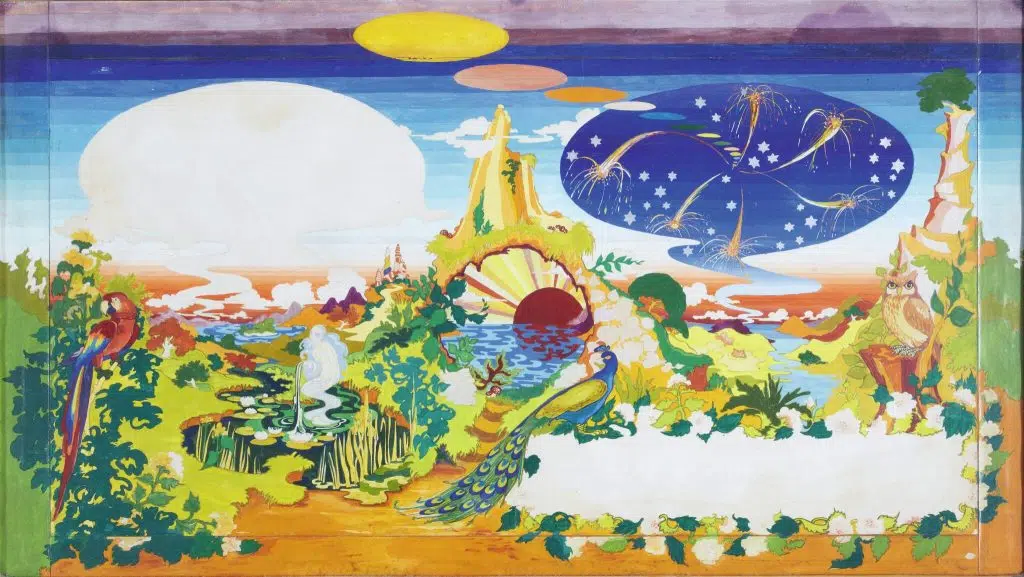
Peter Blake and The Beatles: previous connections
Before the work on the “Sgt. Pepper” cover, they had been some connections between Peter Blake and The Beatles. In 1963, Blake created a portrait of The Beatles, named “The Beatles 1962“, as part of a series based on pop musicians. In 1966, Paul McCartney commissioned a painting from Blake to use in his recently-acquired Scottish farm.
He had just got the Mull of Kintyre [property, in 1966] and had bought a painting of Highland cattle in a stream. I said: ‘Let’s do a picture to match that and I’ll draw a nice stag for you.’ The best stag ever is the Landseer painting The Monarch Of The Glen. I did it in acrylic, which is incredibly stupid, because to get all that mistiness in a paint that dries very quickly is very difficult. It would’ve been much easier to do it in oil paint.
Peter Blake – From artnet.com, February 20, 2017
The mindset in which Blake approached the work on “Sgt. Pepper” was very different from his then-wide Jann Haworth, and maybe explain why the collect memory had kind-of forgotten Haworth’s contribution.
In my mind, I was making a piece of art not an album sleeve.
Peter Blake – From the “Sgt. Pepper’s Lonely Hearts Club Band” box set, 2017
They were a white boy band. I wasn’t that interested in that music. […] It’s just a record cover and I don’t think that’s very important.
Jann Haworth – From Artist Jann Haworth: ‘Sgt Pepper’s is just a record cover and I don’t think that’s very important’ (ft.com), June 5, 2023
Designing the “Sgt. Pepper” cover
Over a series of meetings at Paul McCartney’s London home, in EMI Studios at Abbey Road or in the artists’ home, the cover concept started to emerge. Paul drafted various sketches to fuel the discussions. There was also a theory that Paul may have consciously or unconsciously been inspired by an obscure EP of Beatles covers, released in Sweden in 1964, and that was given to him when The Beatles visited Stockholm in July 1964. Earlier theories around the inspiration for the album cover of “Sgt. Pepper” have brought forth this photo of Jim Mac’s band, the jazz band of Paul’s father, Jim.
The front of the LP includes a colourful collage featuring the Beatles in costume as Sgt. Pepper’s Lonely Hearts Club Band, standing with a group of life-sized cardboard cut-outs of famous people. The centre of the cover depicts the Beatles standing behind a bass drum on which fairground artist Joe Ephgrave painted the words of the album’s title. In front of the drum is an arrangement of flowers that spell out “Beatles”. The group are dressed in satin day-glo-coloured military-style uniforms that were manufactured by the London theatrical costumer M. Berman Ltd. Next to the Beatles are wax sculptures of the band members in their suits and moptop haircuts from the Beatlemania era, borrowed from Madame Tussauds. Amid the greenery are figurines of the Eastern deities Buddha and Lakshmi.
I offered the idea that if they had just played a concert in the park, the cover could be a photograph of the group just after the concert with the crowd who had just watched the concert, watching them. If we did this by using cardboard cut-outs, it could be a magical crowd of whomever they wanted.
Peter Blake – From Mojo Special Limited Edition: 1000 Days That Shook the World (The Psychedelic Beatles – April 1, 1965 to December 26, 1967).
I did drawings of us being presented to the Lord Mayor with lots of dignitaries and friends of ours around. It was to be us in front of a big northern floral clock, and we were to look like a brass band.
Paul McCartney – From the “Sgt. Pepper’s Lonely Hearts Club Band” box set, 2017
I suggested that we all think of heroes that the members of Sgt. Pepper’s Band might have, which would help us fill in their imaginary background story. I did a couple of sketches of how the band might look and, as we made the album, we experienced a sense of freedom that was quite liberating. […] When we were done, I took my sketches and our ideas to a friend of mine, Robert Fraser, a London gallery owner who represented a number of artists. He suggested we take the idea to Peter Blake, and John and I had discussions with Peter about the design of the album cover. Peter and his then wife Jann Haworth had some interesting additional ideas and we all had an exciting time putting the whole package together.
Paul McCartney – From the “Sgt. Pepper’s Lonely Hearts Club Band” box set, 2017
Paul now says that he came up with the original sketch showing the band standing in front of a crowd – but he really didn’t have much of an idea what he wanted. There’s also a sketch of the cover by John Lennon coming up for auction soon, expected to fetch £50,000 or more – but that was absolutely drawn after we’d designed the album. It includes details that we only added at the last minute.
Jann Haworth – From Express.co.uk, May 13, 2017
Robert Fraser, a friend of the Stones, owned the gallery I was with. A cover for Sgt Pepper designed by The Fool already existed and was very psychedelic – swirly orange and green and purple – there were a lot of others like it. Robert thought it would be interesting to have the first cover done by a fine artist as opposed to a record cover designer. A certain amount had already been established: the concept of their being a band within a band, for instance. They’d had their uniforms made already. I think my contribution was to talk a great deal to them about the concept and try to add something visual to it. Paul explained that it was like a band you might see in a park. So the cover shot could be a photograph of them as though they were a town band finishing a concert in a park, playing on a bandstand with a municipal flowerbed next to it, with a crowd of people around them. I think my main contribution was to decide that if we made the crowd a certain way the people in it could be anybody. I think that that was the thing I would claim actually changed the direction of it: making a life-sized collage incorporating real people, waxworks, photographs and artwork. I kind of directed it and asked the Beatles and Robert (and maybe other people, but I think it was mainly the six of us) to make a list of characters they would like in a kind of magical ideal film, and what came out of this exercise was six different sets of people. Robert Frazer chose artists, and I chose Johnny Weissmuller, people like Bobby Breen who was a child star, and Shirley Temple. And then we went to Madame Tussaud’s where I heard Sonny Liston would probably be melted down soon. He was no longer world champion, and so I got him and I still have him.
Peter Blake – From “It Was Twenty Years Ago Today” by Derek Taylor, 1967
A very strange scene met us the first time we went over to the studio. The Beatles were recording, and their ‘court’ of Marianne Faithfull and all these weird spaced-out people sat around the walls. Peter and I were probably the only people who were stone-cold sober. It was really funny, two very upright people doing this psychedelia.
Paul played us the tape of Sgt Pepper, which was still being worked on, and Peter thought the idea of making a Lonely Hearts Club would be interesting, a group of people with the Beatles in front. Early in the sixties Peter had done some things, cutting out Victorian heads, engravings, sticking them down, then doing a circus act in front of that. He maintained at that time that Paolozzi nicked that idea from him, the collage effect of people and things, dissimilar but in the same environment.
Jann Haworth – From “Groovy Bob: The Life and Times of Robert Fraser” by Harriet Vyner, 1999
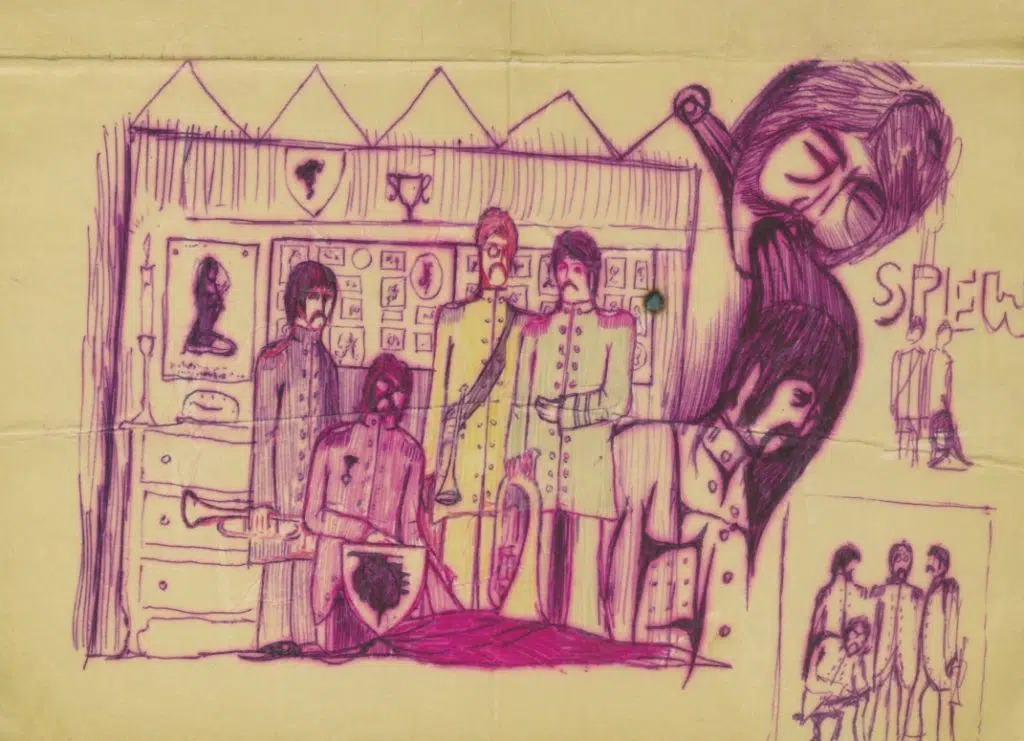
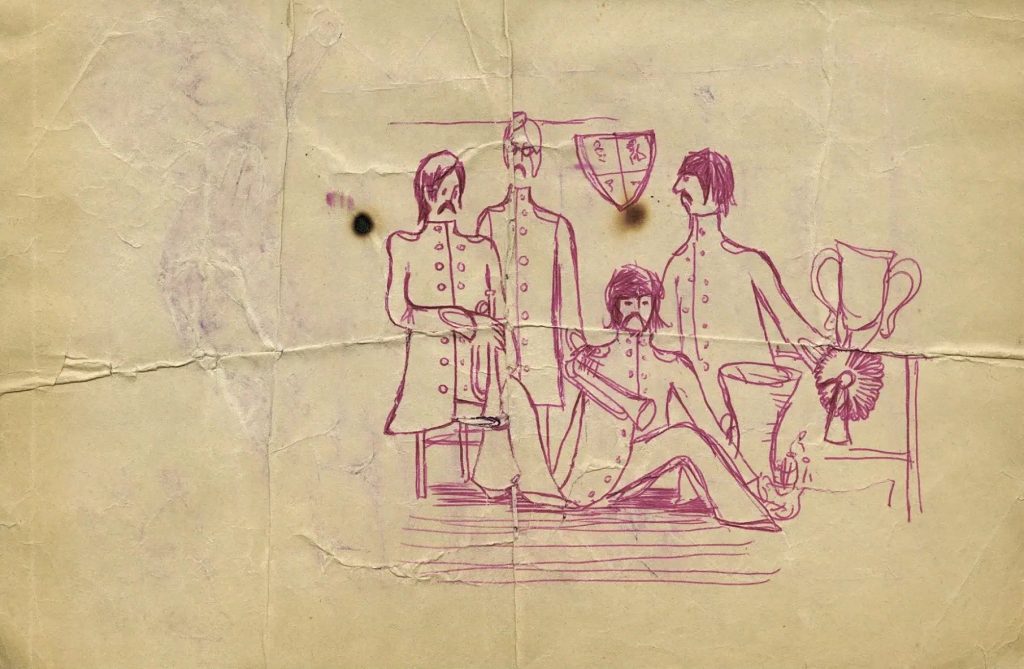
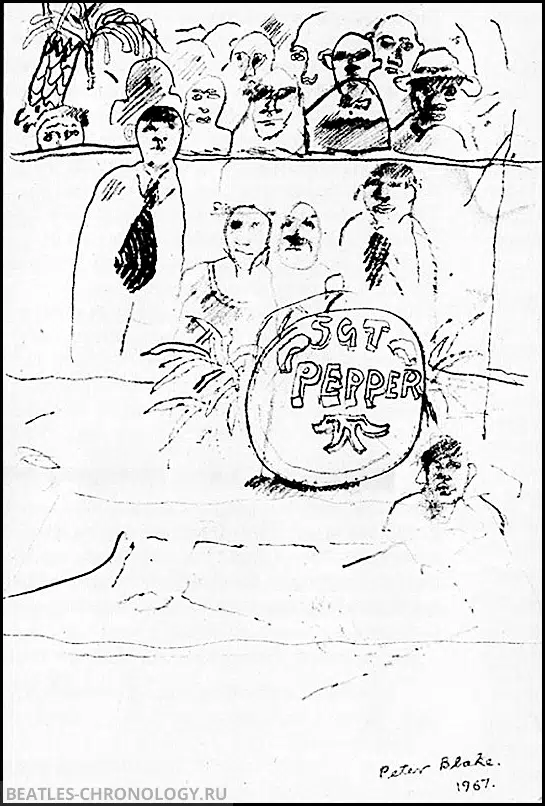
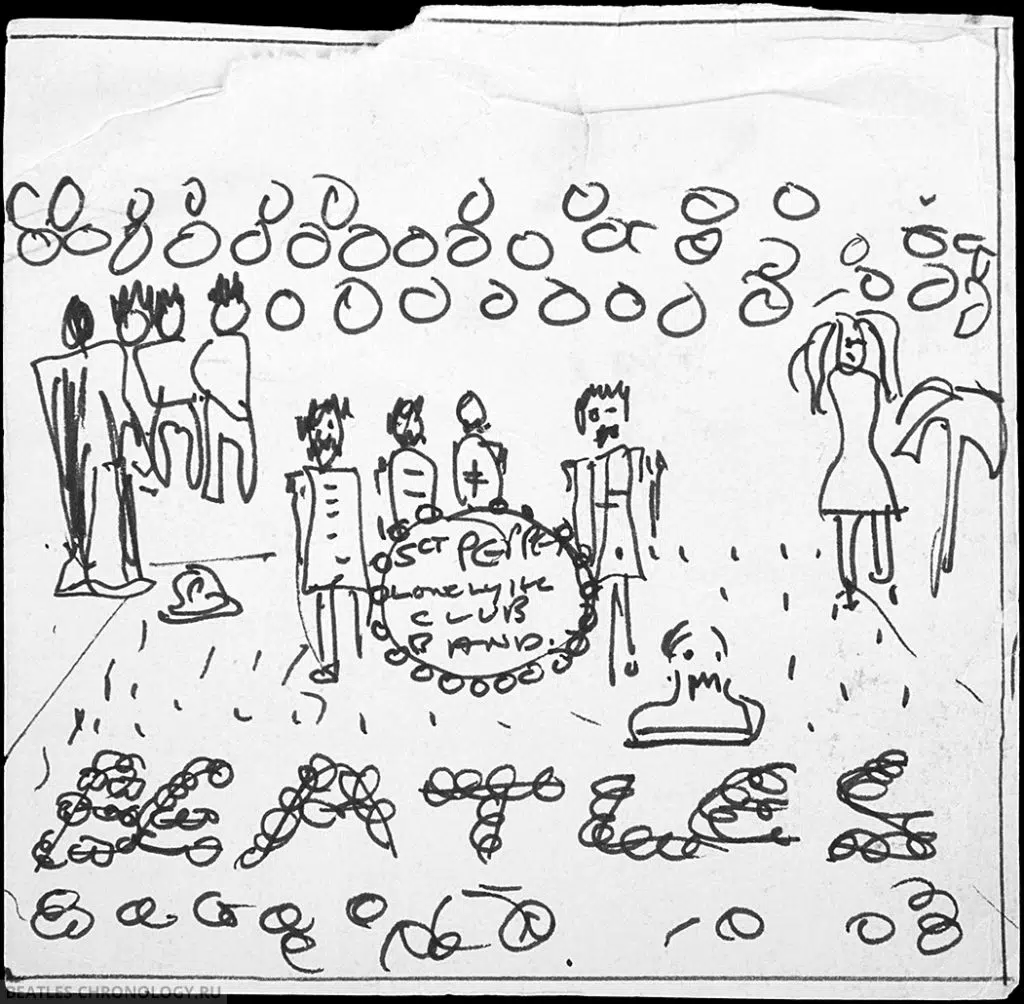
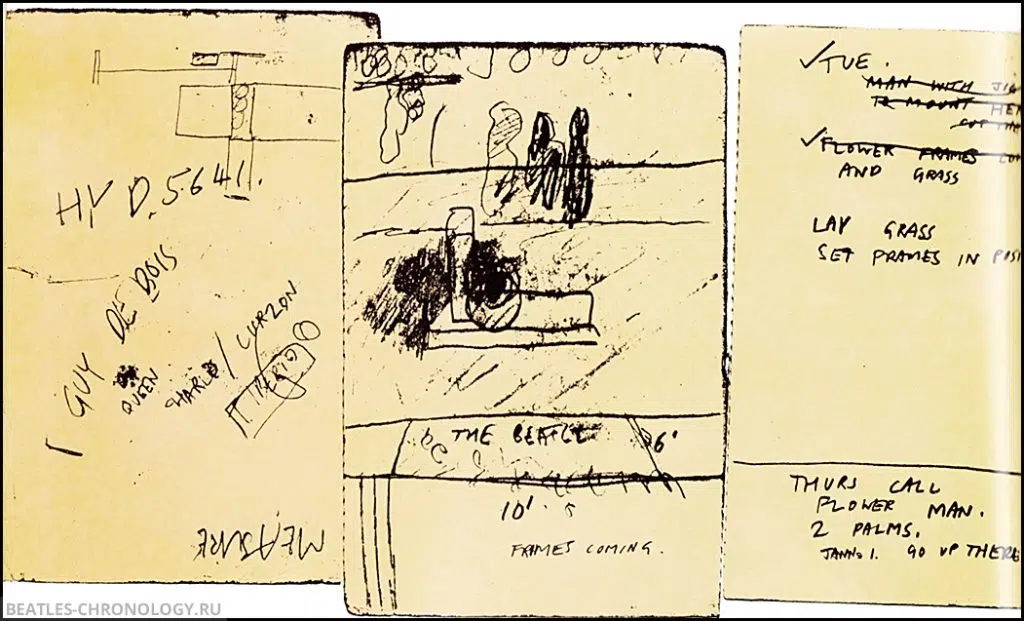
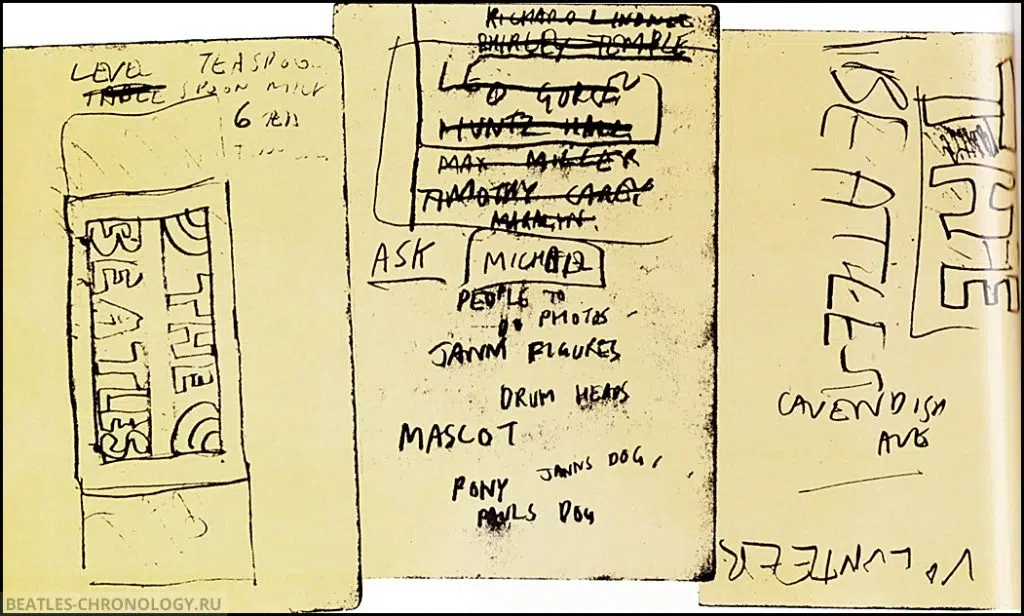
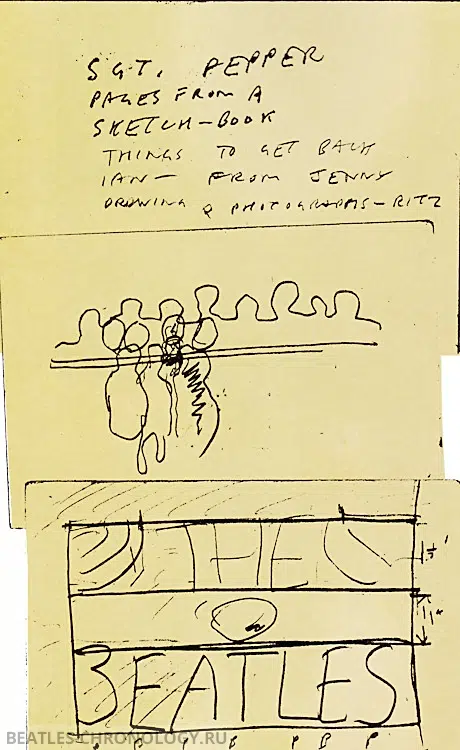
Selecting the famous people who would appear in the background
It was a group effort to decide which famous people should appear as life-sized cardboard cut-outs, with contributions from John Lennon, Paul McCartney, George Harrison, Robert Fraser, Peter Blake and Jann Haworth. According to Peter Blake, Ringo Starr didn’t suggest name.
In the end, the cover collage includes 57 photographs and nine waxworks. It is not known for sure who chose who. However, John suggested Jesus and Adolf Hitler, but it was deemed safer not to include any of them. George suggested Mahatma Gandi and several Yogis. Gandi was however rejected by Sir Joseph Lockwood, the chairman of EMI, by fear of a negative impact on sales in India.
The other part of my concept was to get everyone in the group to mention their heroes. You’d have a portrait of someone and around him would be all the little portraits of Brando, James Dean, an Indian guru, whoever you were into. Or rather the alter ego’s heroes. There’d be H. G. Wells and Johnny Weissmuller, Issy Bonn and all those people, and Burroughs would have been a suggestion probably from Robert, and there were a few kind of LA guys that Robert had slipped in. He’d slip in people that we didn’t even know but we didn’t mind, it was the spirit of the thing. Those ideas developed and combined, so that instead of a mayoral presentation it became that famous cover.
Paul McCartney – From “Groovy Bob: The Life and Times of Robert Fraser” by Harriet Vyner, 1999
My father was an Oscar-winning production designer on films including Some Like It Hot, The Longest Day and Sayonara. I grew up on film sets and often saw my father craft scenes with two-dimensional cut-out figures in the background where they could look like a crowd. It was my idea that the front row be three-dimensional with The Beatles, behind them mannequins and full-size fabric dolls that I crafted, and behind those a two-dimensional flat frame filled with celebrity faces.
We wanted at least 70 figures and asked The Beatles to list their heroes. But McCartney and John Lennon combined barely suggested 20 names. George Harrison came up with a few Indian gurus that we included. Ringo claims that he came up with no one but I remember he selected the music-hall artist Issy Bonn, plus another celebrity who never made it on to the cover. John wanted Adolf Hitler, which I thought was a very ugly choice, beyond provocative. I have no idea what his thinking was. I think he has clay feet. We decided not to use Hitler. Aleister Crowley [a prominent satanist who had died in 1947] also made me uncomfortable. I don’t like the occult but he stayed in.
John also wanted Gandhi and Jesus on the cover, but using Jesus seemed sacrilegious, and The Beatles management decided not to use Gandhi because it might hurt sales in India, so both were dropped.
Looking back, I’m horrified that of 71 famous faces, the Beatles chose no women. Peter and I added only 12 women and three of those were Shirley Temple. The rest were pin-ups, mannequins or blondes such as Mae West and Diana Dors. If we made the cover today we would never have allowed such inequality. It’s partly my fault. I take responsibility. I should have known better.
Jann Haworth – From Express.co.uk, May 13, 2017
Why did you put all those people on the cover, like a school photograph gone wrong?
These were all just cult heroes. George chose a few of his schoolmates he liked; and the rest of us said names we liked the sound of: like Aldous Huxley, H. G. Wells, Johnny Weissmuller.
Those Indian people have amazing stories. There’s one called Yogananda Para Manza, who died in 1953 and left his body in an incredibly perfect state. Medical reports in Los Angeles three or four months after he died were saying this is incredible; this man hasn’t decomposed yet. He was sitting there glowing because he did this sort of transcendental bit, transcended his body by planes of consciousness. He was taught by another person on the cover and he was taught by another, and it all goes back to the one called Babujee who’s just a little drawing looking upwards.
You can’t photograph him – he’s an agent. He puts a curse on the film. He’s the all-time governor, he’s been at it a long time and he’s still around doing the transcending bit.
These are all George’s heroes?
Yes. George says the great thing about people like Babujee and Christ and all the governors who have transcended is that they’ve got out of the reincarnation cycle: they’ve reached the bit where they are just there; they don’t have to zoom back.
So they’re there planning the spiritual thing for us. So, if they are planning it, what a groove that he’s got himself on our cover, night in the middle of the Beatles’ LP cover! Normal ideas of God wouldn’t have him interested in Beatles music or any pop – it’s a bit infra dig – but obviously, if we’re all here doing it, and someone’s interested in us, then it’s all to do with it. There’s not one bit worse than another bit. So that’s great, that’s beautiful that he’s right on the cover with all his mates.
Paul McCartney – Interview with The Observer, November 1967
Jesus and Hitler were on John’s favourites list, but they had to be taken off. John was that kind of guy, but you couldn’t very well have Hitler and so he had to go. Gandhi also had to go, because the head of EMI, Sir Joseph Lockwood, said, ‘In India, they won’t allow the record to be printed.’ There were a few people who just went by the wayside.
Paul McCartney – From “The Beatles: Off the Record” by Keith Badman, 2008
I said, “Why not [Gandi]? We’re revering him.” – “Oh, no, no. It might be taken the wrong way. He’s rather sacred in India, you know.”
Paul McCartney – citing the reaction of Sir Joseph Lockwood, regarding the inclusion of Gandi
There’s one or two on there that a lot of people would not even know. There’s the obvious ones, like Marilyn Monroe, and there’s an old singer on there called Izzy Bon …
Alistair Taylor – From “The Beatles: Off the Record” by Keith Badman, 2008
The photo shoot
On March 30, …
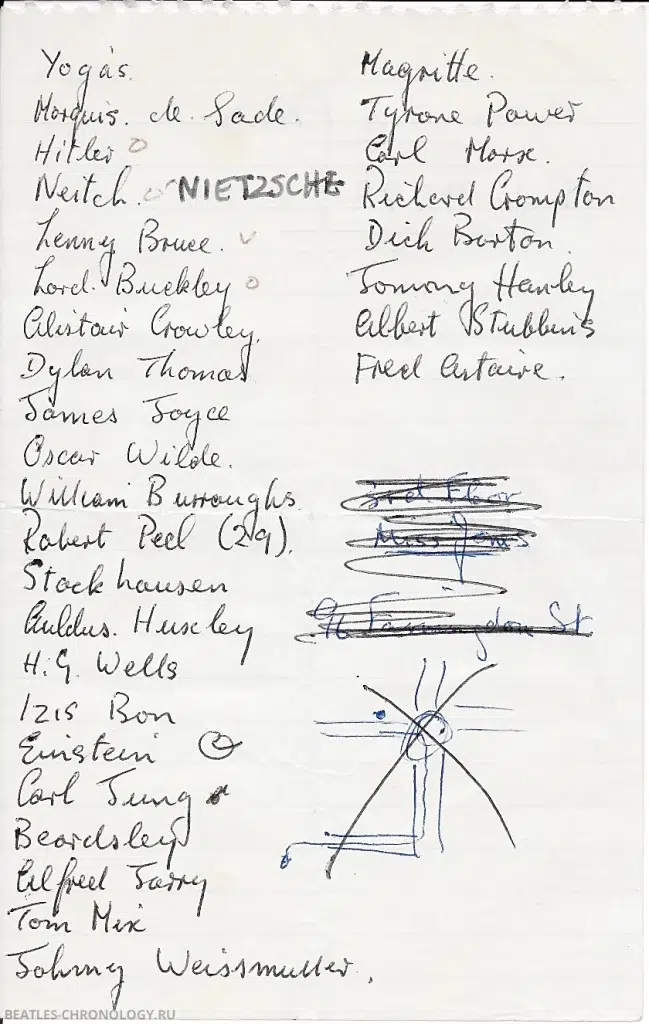
Getting approval for the famous people appearing on the cover
A validation process was done to ensure
We had to get permission and pay a royalty to everyone on the sleeve. In fact, a lovely lady, called Wendy Hanson, Brian’s PA, had to find all these people and pay them a half penny.
Alistair Taylor – From “The Beatles: Off the Record” by Keith Badman, 2008
Brian asked me to try and get legal clearances from everybody within a week. EMI wasn’t keen on the cover, but Paul wanted to do it. It was an incredible job. I spent many hours and pounds on calls to the States. Some people agreed to it, but others wouldn’t. Fred Astaire was very sweet and Shirley Temple wanted to hear the record first. I got on famously with Marlon Brando, but Mae West wanted to know what she would be doing in a lonely hearts club.
Wendy Hanson, Brian Epstein’s personal assistant – From “The Beatles: Off the Record” by Keith Badman, 2008
Mae West replied, ‘No, I won’t be in it. What would I be doing in a lonely hearts club?’ So, The Beatles wrote her a personal letter and she changed her mind.
Peter Blake – From “The Beatles: Off the Record” by Keith Badman, 2008
When McCartney was asked why the Beatles did not include Elvis Presley among the musical artists, he replied: “Elvis was too important and too far above the rest even to mention.” Starr was the only Beatle who offered no suggestions for the collage, telling Blake, “Whatever the others say is fine by me.” The final cost for the cover art was nearly £3,000 (equivalent to £58,000 in 2021), an extravagant sum for a time when album covers would typically cost around £50 (equivalent to £1,000 in 2021).
The cover, designed by pop artist Peter Blake, was a collage of photographs, with the Beatles dressed in brightly colored satin Victorian militia uniforms, surrounded by a surreal collage of sixty-two faces, including those of Marilyn Monroe, Marlon Brando, Carl Jung, Edgar Allan Poe, Bob Dylan, and Stu Sutcliffe. Brian hit the roof when he saw the cover and realized the legal entanglements of getting permission to use the photographs. He begged the boys to use a brown paper bag as the album cover instead, but the Beatles insisted it be kept the way it was. In the end, the Beatles had to indemnify EMI for £20 million against possible lawsuits.
From “The Love You Make: An Insider’s Story of the Beatles” by Peter Brown and Steven Gaines, 2002
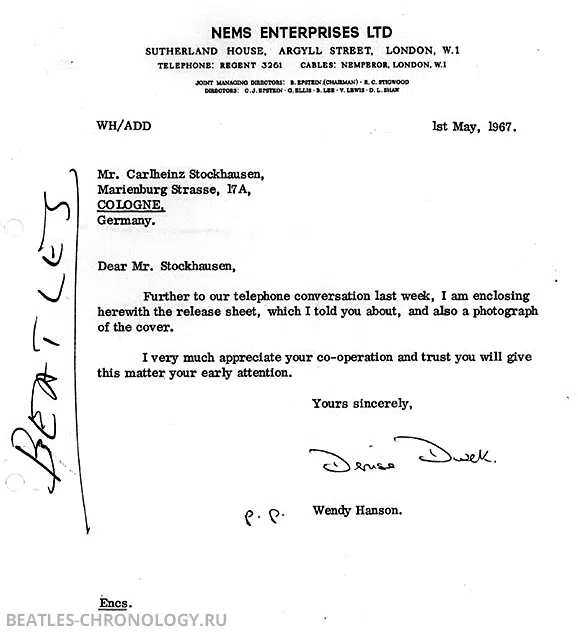
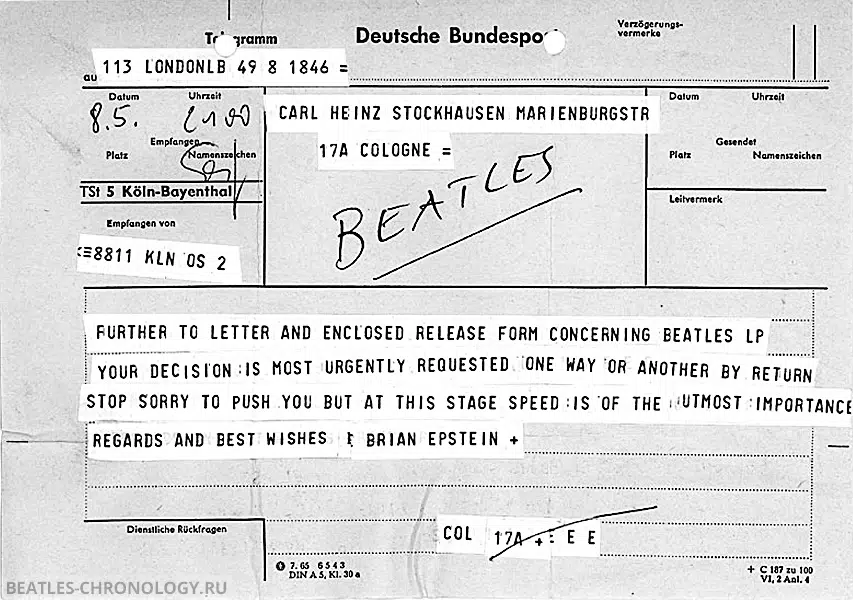
It was Haworth’s idea to have The Beatles’ name spelled out in flowers.
When we were designing the cover Paul came over to our house in Chiswick and I showed him a sketch of how we could spell out ‘Beatles’ in flowers, like they do with civic clocks,” she says. “Paul liked the idea, and we planned to use colourful little flowers like cyclamen. But when the florist arrived, he brought horrible hyacinths which are tall and thin, and made it much harder to spell anything.
We spent almost two weeks constructing the set at the studio of photographer Michael Cooper, who shot the final image. We were printing black and white images of the celebrity faces, gluing them to hardboard, cutting them out with a jig-saw, and fixing them to the backdrop. I hand-coloured most myself. I started with Tyrone Power, which is why he looks as orange as Donald Trump. I went lighter with the colour after that.
At the last minute Madame Tussauds agreed to lend us their four Beatles waxwork figures, plus Diana Dors, HG Wells, Lawrence of Arabia and Sonny Liston. Paul invited us to his home, driving through a crowd of screaming, crying fans, to play us a few tracks from the album. I wish I’d heard Lucy In The Sky With Diamonds, because I would have painted the sky black instead of blue.
Jann Haworth – From Express.co.uk, May 13, 2017
The part that’s very much my own was that I always hated lettering on things. I loved the idea that lettering could be an integral part, and I was into fairground lettering at the time. So I thought it would be nice to have a real object with lettering on it, instead of lettering the cover. So I thought about the drum, then about the civic lettering that was around at that time. We pointed out to Paul the Hammersmith lettering: You could do it like that.
What I wanted was that very tight, little ice plants, a very tight floral near-tothe-ground thing. I discussed all this on the phone with the florists. Then they turned up with all these dumb plants — hyacinths. And then only a quarter of what we needed to cover the whole thing. After all these instructions. At least when they set it out you could read the word ‘Beatles’, but it was very much a failure in terms of the original concept.
The other part I felt very strongly about was that when you went from the front, you wanted to have that connecting point of 3-D things that bled into the 2-D things, as we were not doing it as artwork. This bothered Peter a lot later, because it was so retouched, so messed about, the photograph, it ended up looking like artwork, a collage done on paper, rather than a set that was built. Madame Tussaud’s were very generous, lending us some figures, and then the Beatles were going to be in front of the crowd, and I put some of my figures in, and that blended the 3-D world into the 2-D world.
Jann Haworth – From “Groovy Bob: The Life and Times of Robert Fraser” by Harriet Vyner, 1999
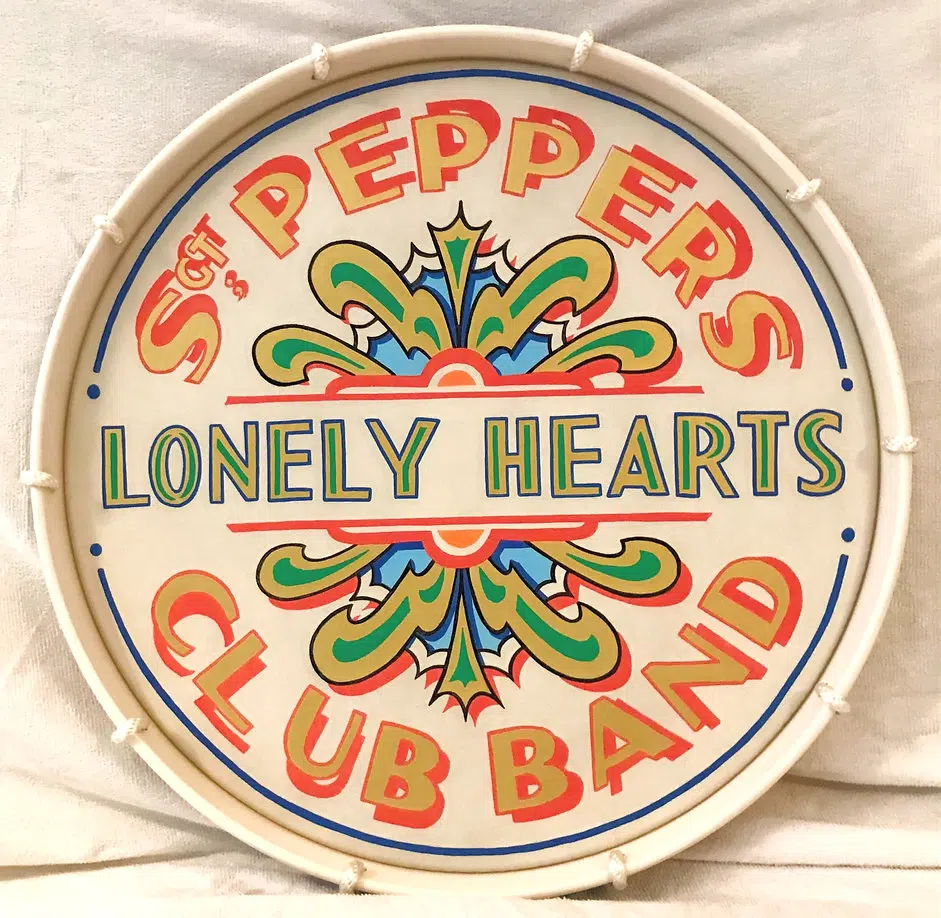
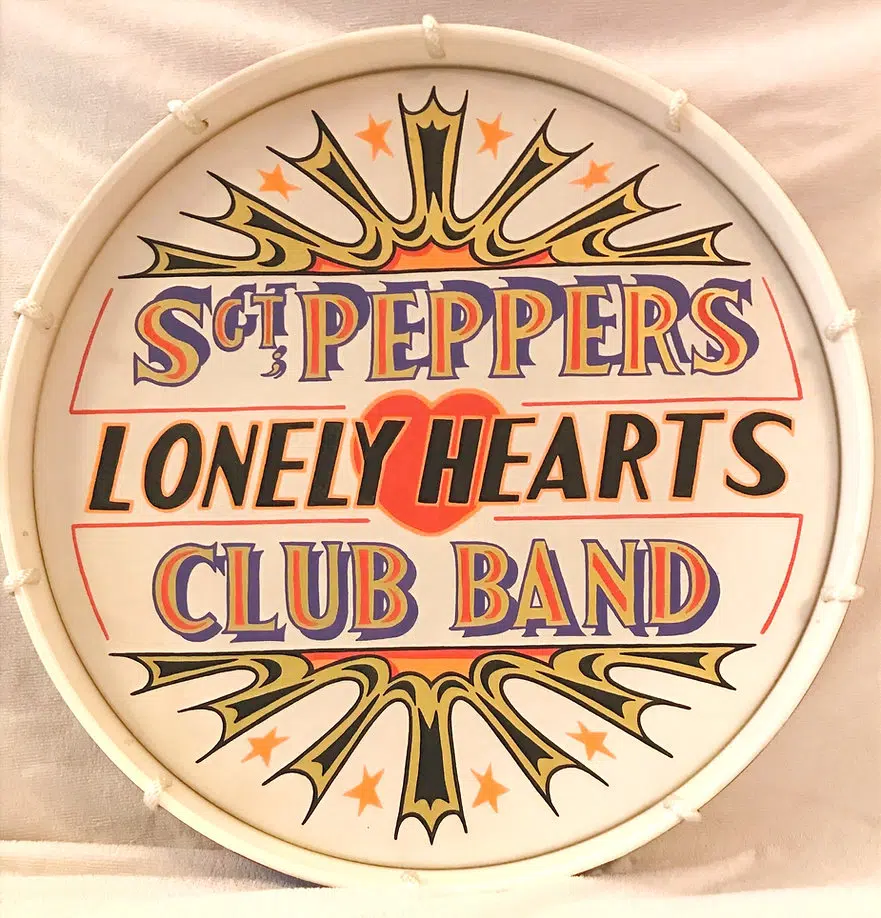
The packaging : Back cover, gatefold and cut-outs
The 30 March 1967 photo session with Cooper also produced the back cover and the inside gatefold, which Inglis describes as conveying “an obvious and immediate warmth … which distances it from the sterility and artifice typical of such images”. McCartney recalled the inner-gatefold image as an example of the Beatles’ interest in “eye messages”, adding: “So with Michael Cooper’s inside photo, we all said, ‘Now look into this camera and really say I love you! Really try and feel love; really give love through this!’ … [And] if you look at it you’ll see the big effort from the eyes.” In Lennon’s description, Cooper’s photos of the band showed “two people who are flying [on drugs], and two who aren’t”.
The album’s lyrics were printed in full on the back cover, the first time this had been done on a rock LP. The record’s inner sleeve featured artwork by the Dutch design team the Fool that eschewed for the first time the standard white paper in favour of an abstract pattern of waves of maroon, red, pink and white. Included as a bonus gift was a sheet of cardboard cut-outs designed by Blake and Haworth. These consisted of a postcard-sized portrait of Sgt. Pepper (probably based on a photograph of British Army officer James Melville Babington, but also noted as being similar to a statue from Lennon’s house that was used on the front cover), a fake moustache, two sets of sergeant stripes, two lapel badges, and a stand-up cut-out of the band in their satin uniforms. Moore writes that the inclusion of these items helped fans “pretend to be in the band”.
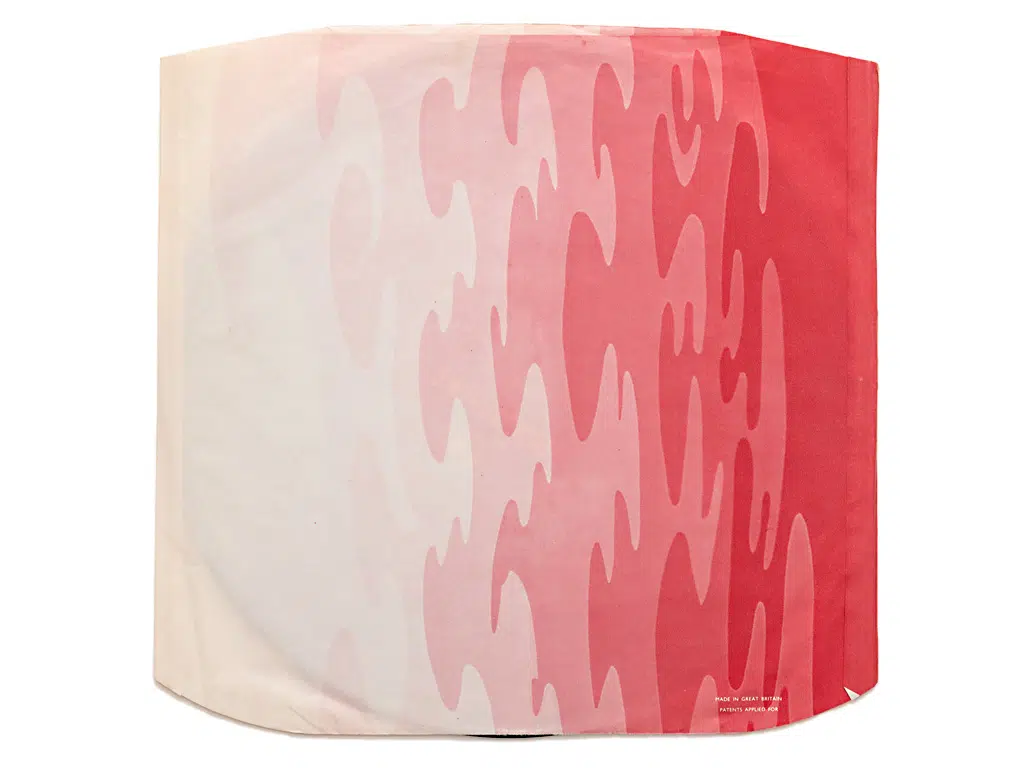
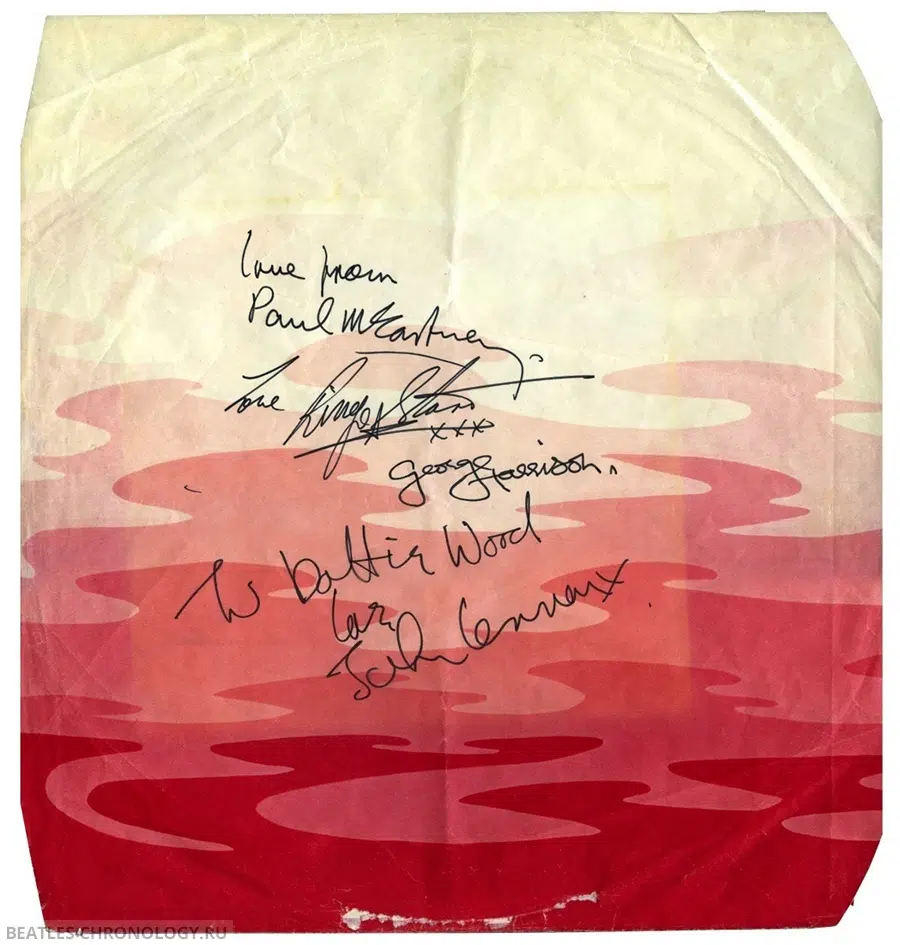
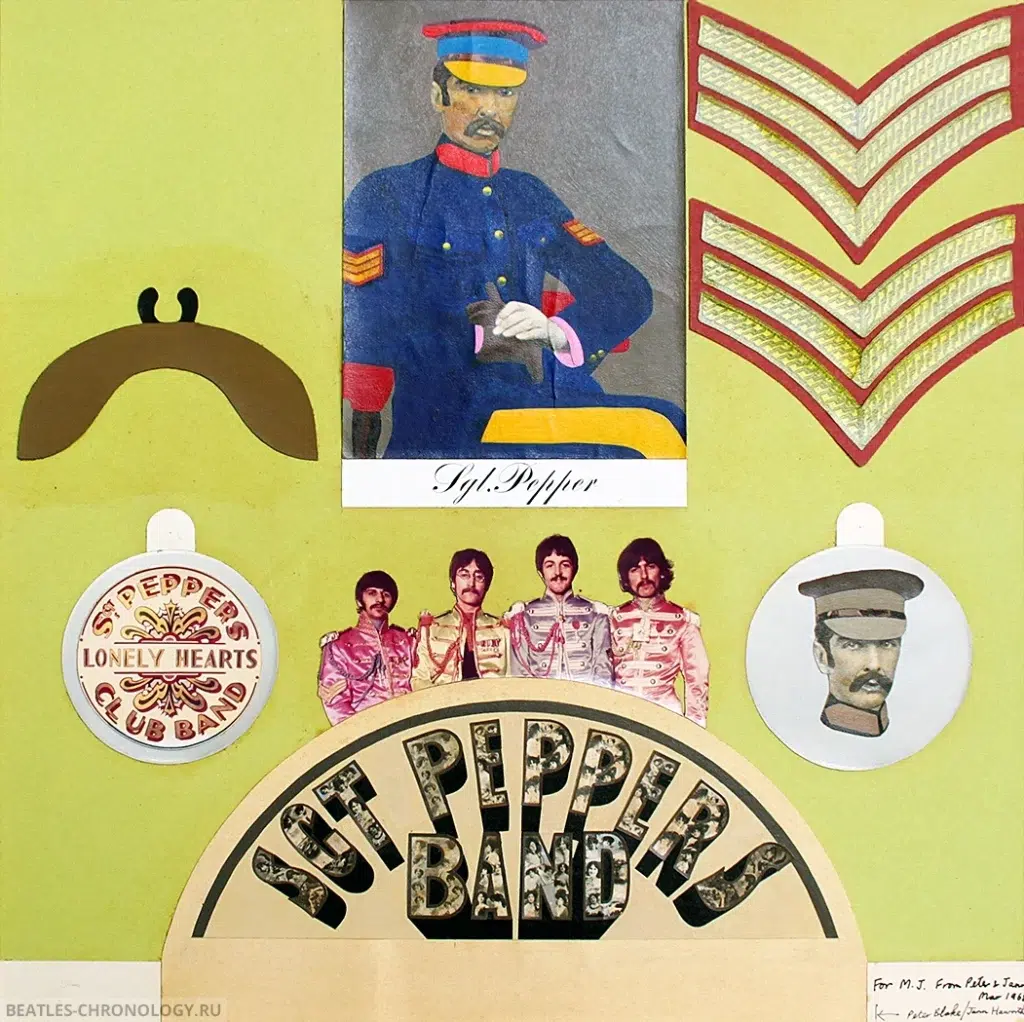
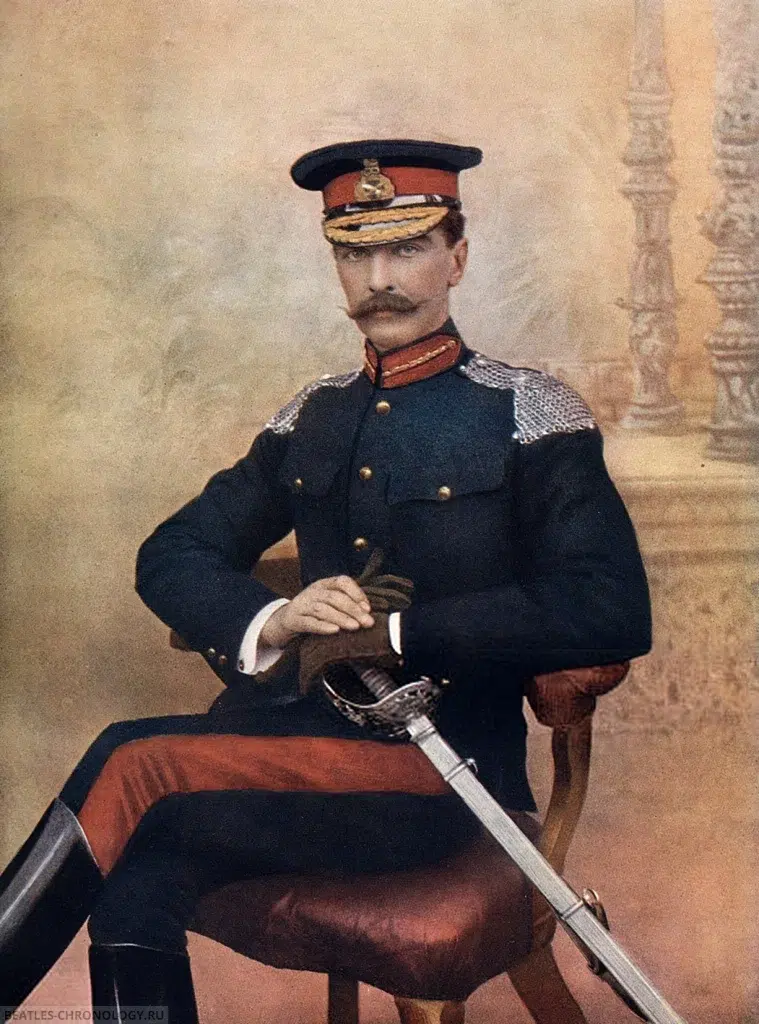
For our outfits, we went to Berman’s, the theatrical costumiers, and ordered up the wildest things, based on old military tunics. That’s where they sent you if you were making a film: ‘Go down to Berman’s and get your soldier suits.’ They had books there that showed you what was available. Did we want Edwardian or Crimean? We just chose oddball things from everywhere and put them together. We all chose our own colours and our own materials: ‘You can’t have that, he’s having it…’
We went for bright psychedelic colours, a bit like the fluorescent socks you used to get in the Fifties (they came in very pink, very turquoise or very yellow). At the back of our minds, I think the plan was to have garish uniforms which would actually go against the idea of uniform. At the time everyone was into that ‘I Was Lord Kitchener’s Valet’ thing; kids in bands wearing soldiers’ outfits and putting flowers in the barrels of rifles.
Paul McCartney – From “The Beatles Anthology” book, 2000
When the shoot was over, much of the set was simply thrown away. We had no idea it would be part of rock ’n’ roll history. Someone grabbed the drum skins reading ‘Sgt Pepper’s Lonely Hearts Club Band’, which we’d paid £25 to have made. They later sold for $1million.
Jann Haworth – From Express.co.uk, May 13, 2017
The back took some time and had to be left till last because we were printing lyrics and they had to be designed and we had to have a running order and we couldn’t have that until everyone had decided on it. I remember Paul and I walking along, I think Kingly Street in the West End, trying to work out some clever word using the initial letter of each song – the first would have to be S for Sgt Pepper and then we’d try and get a vowel, say – but we couldn’t get it right, so the running order was decided in another way. But it all worked out and we made it on time.
Neil Aspinall – From “It Was Twenty Years Ago Today” by Derek Taylor, 1967
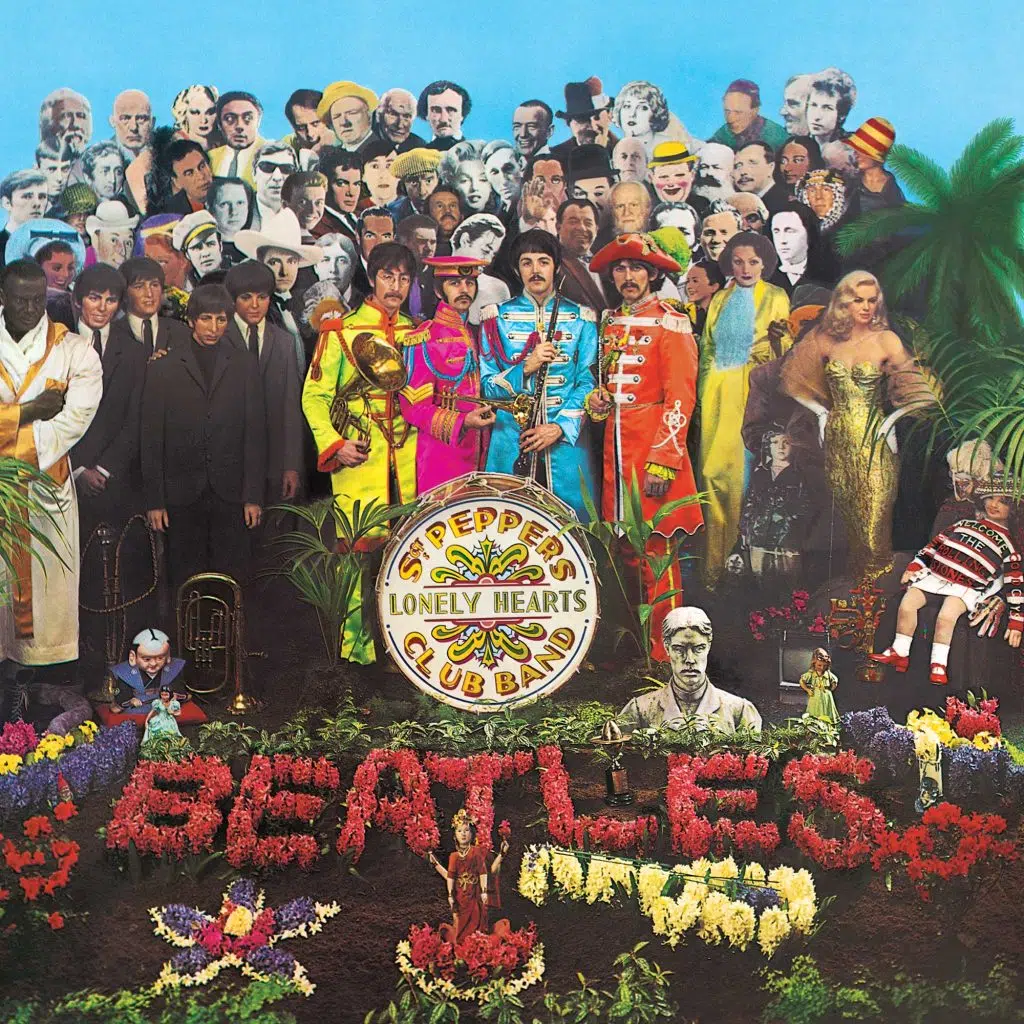
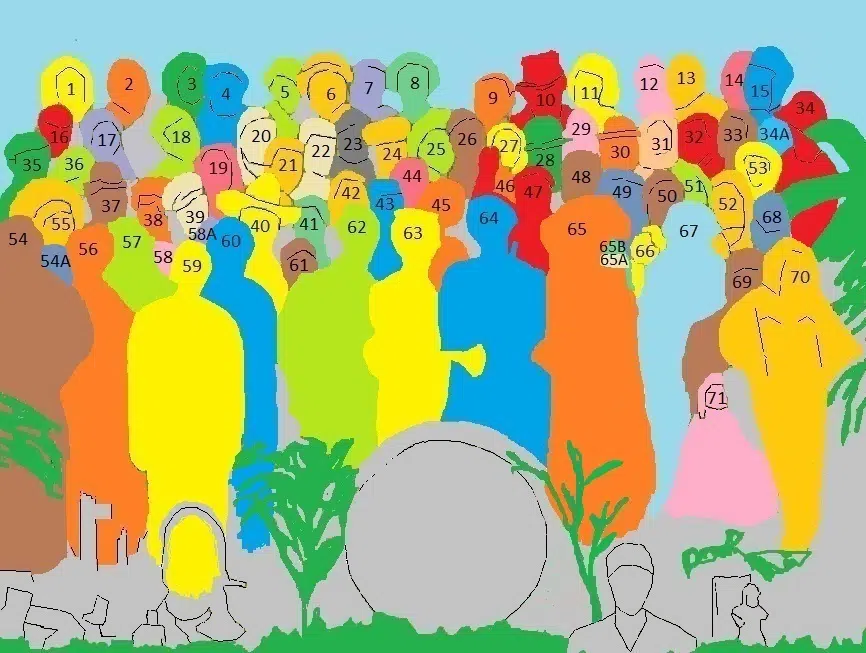
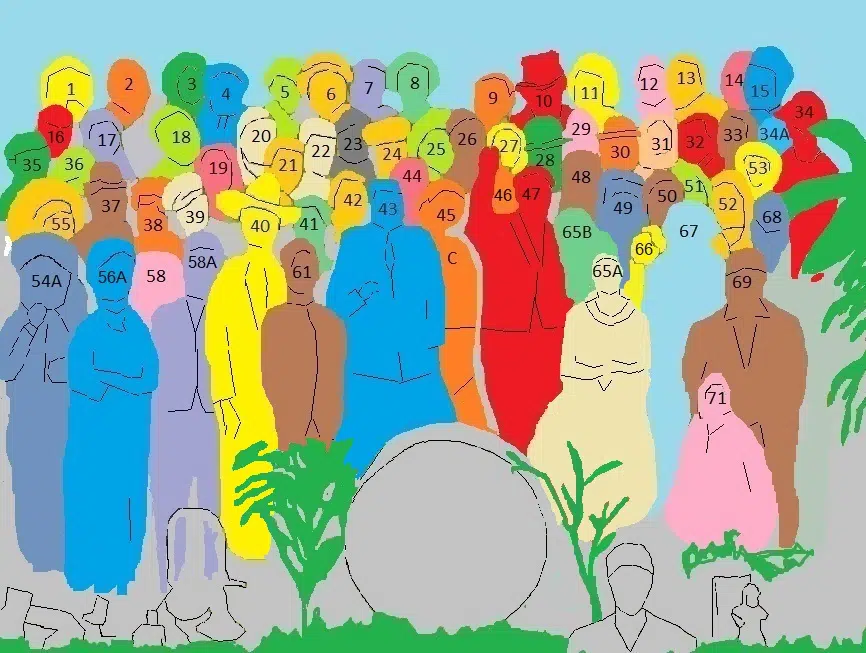
Top row
- (1) Sri Yukteswar Giri (Hindu guru) – The author of the 1894 book The Holy Science, which attempted “to show as clearly as possible that there is an essential unity in all religions”, Sri Yukteswar Giri was guru to both Sri Mahavatara Babaji (No.27) and Paramahansa Yogananda (No.33). His prominent position in the top left-hand corner reflects George Harrison’s (No.65) growing interest in Indian philosophy.
- (2) Aleister Crowley (occultist) – A hugely prolific author who identified with occultism and formed his own religion, Thelema, Crowley’s central tenet was, “Do what thou wilt shall be the whole of the law. Love is the law, love under will.”
- (3) Mae West (actress) – Mae West initially refused to allow her image to appear on the artwork. She was, after all, one of the most famous bombshells from Hollywood’s Golden Age and felt that she would never be in a lonely hearts club. However, after The Beatles personally wrote to her explaining that they were all fans, she agreed to let them use her image.
- (4) Lenny Bruce (comedian) – Lenny Bruce revolutionised comedy in the 50s and 60s, ushering in a personalised style that influenced many later comedians. By the time he appeared on the Sgt. Pepper cover, he had been arrested for obscenity, further making him a countercultural hero not only for The Beatles, but also the Beatniks and Bob Dylan (No.15). He died of a drug overdose in August, 1966.
- (5) Karlheinz Stockhausen (composer) – A German composer who pioneered the use of electronic music in the 50s and 60s, Stockhausen remains a godfather of the avant-garde, whose boundary-pushing music influenced The Beatles’ own groundbreaking experiments in the studio, starting with their tape experiments of Revolver’s ‘Tomorrow Never Knows’. Paul McCartney (No.64) introduced Stockhausen’s work to the group, turning John Lennon (No.62) into a fan; Lennon and Yoko Ono even sent the composer a Christmas card in 1969.
- (6) W. C. Fields (comedian/actor) – An American writer, comedian and actor, WC Fields was the epitome of the all-round entertainer, whose career spanned both the silent-film era and the talkies.
- (7) Carl Jung (psychiatrist) – Another progressive thinker who introduced new strains of psychology to the world, Jung was a Swiss psychiatrist whose Analytic Psychology school of thought pioneered the concept of individuation and self-realisation in the early 1900s.
- (8) Edgar Allan Poe (writer) – Before being namechecked in ‘I Am The Walrus’, Edgar Allan Poe appeared on the right-hand side of the top row of the Sgt. Pepper collage. The poems and short stories that he wrote across the 1820s and 1840s essentially invented the modern horror genre, and also helped lay the groundwork for sci-fi and detective stories as we know them today.
- (9) Fred Astaire (actor/dancer) – In contrast to Mae West (No.3), Fred Astaire was reportedly thrilled to be asked to appear on the Sgt Pepper album cover. A child star who initially started dancing with his sister on stage, it was with Ginger Rogers that Fred made his greatest mark, in a series of classic Golden Age movies including Top Hat and Swing Time. Fred also appeared with John and Yoko in the 1972 television film Imagine.
- (10) Richard Merkin (artist and friend of Peter Blake) – Born in 1938, American painter and illustrator Richard Merkin was enamoured with the early jazz period that flourished in the years before his birth. His modernist style matched the abstraction of jazz music, and also inspired Peter Blake’s tribute artwork, Souvenirs For Richard Merkin, created in 1966.
- (11) The Vargas Girl (by artist Alberto Vargas) – Having made a name for himself designing posters for the Ziegfield Follies that appeared on Broadway across the 1910s to the 30s, Peruvian painter Joaquin Alberto Vargas Y Chávez went on to create a series of paintings of pin-ups. Known as the Varga Girls, they gained widespread exposure in Esquire magazine during the 40s, and also inspired a number of paintings that would appear on World War II fighter jets.
- (12) Leo Gorcey (image was removed from cover, but a space remains)
- (13) Huntz Hall (actor) – A fellow Bowery Boy, Huntz Hall was known for playing the putz of the group, Horace DeBussy “Sach” Jones.
- (14) Simon Rodia (designer and builder of the Watts Towers) – Born in Italy in 1879, Simon Rodia emigrated to the United States with his brother when he was 15. Living in various places for the next 35 years, Rodia finally settled in the Watts district of Los Angeles in 1920, and began constructing the Watts Towers the following year. Consisting of 17 interconnected sculptures, the project took Rodia 33 years to complete.
- (15) Bob Dylan (singer/songwriter) – Dylan and The Beatles influenced each other throughout the 60s, each spurring the other on to making music that pushed boundaries and reshaped what was thought possible of the simple “pop song”. It was Dylan who convinced John Lennon (No.62) to write more personal songs in the shape of ‘Help!’, while The Beatles showed Bob what could be achieved with a full band behind him, helping the latter “go electric” in 1965. It was with George Harrison (No.65), however, that Dylan struck up the longest-lasting friendship; the two played together often in the years that followed, forming The Traveling Wilburys and guesting on each other’s projects.
Second row
- (16) Aubrey Beardsley (illustrator) – The influence of Aubrey Beardsley’s pen-and-ink line drawings had already made itself felt on Klaus Voormann’s artwork for Revolver, and here the 19th-century illustrator, whose own style was influenced by Japanese woodcutting, takes a position not too far away from Oscar Wilde (No.41), Beardsley’s contemporary in the Aesthetic movement.
- (17) Sir Robert Peel (19th century British Prime Minister) – A founder of the modern Conservative Party, Sir Robert Peel served as the UK’s Prime Minister on two separate occasions, 1834-35 and 1841-46. While he served as the UK’s Home Secretary, Peel also helped form the modern police force – and his name is still evoked today, with the terms “bobbies” and “peelers” referring to policemen in England and Ireland, respectively.
- (18) Aldous Huxley (writer) – Published in 1954, Aldous Huxley’s work, The Doors Of Perception, was required reading for the countercultural elite in the 60s. Detailing the author’s own experience of taking mescaline, it chimed with the consciousness-expanding ethos of the decade, and even gave The Doors their name. He was nominated for the Nobel Prize for Literature in seven different years and died on 22 November 1963, the same day that both With The Beatles was released and President John F Kennedy was assassinated.”
- (19) Dylan Thomas (poet) – A beloved Welsh writer who died in 1953, The Beatles had all been fans of Dylan Thomas’ poetry by the time it came to creating the Sgt. Pepper artwork. “We all used to like Dylan Thomas,” Paul McCartney (No.64) later recalled. “I read him a lot. I think that John started writing because of him.” The late Sir George Martin was also a fan, and produced a musical version of Thomas’ radio play, Under Milk Wood, in 1988.
- (20) Terry Southern (writer) – A satirical novelist and screenwriter, Terry Southern bridged the gap between the Beat Generation and The Beatles; he hung out with the former in Greenwich Village, and befriended the latter after moving to London in 1966. His dialogue was used in some of the most era-defining movies of the 60s, including Dr Strangelove Or: How I Learned To Stop Worrying And Love The Bomb and Easy Rider.
- (21) Dion DiMucci (singer/songwriter) – Originally the leader of Dion And The Belmonts, Dion DiMucci established a successful solo career with hits such as ‘The Wanderer’ and ‘Runaround Sue’ – doo-wop songs which characterised the rock’n’roll era that so influenced The Beatles.
- (22) Tony Curtis (actor) – Striking and versatile, Tony Curtis was a Hollywood idol who made a dizzying amount of movies (over 100) between 1949 and 2008. He will always be remembered for his role alongside Jack Lemmon and Marilyn Monroe (No.25) in the 1959 cross-dressing caper Some Like It Hot, but another stand-out remains his performance alongside Burt Lancaster as fast-talking press agent Sidney Falco in the 1957 film noir The Sweet Smell Of Success.
- (23) Wallace Berman (artist)
- (24) Tommy Handley (comedian)
- (25) Marilyn Monroe (actress)
- (26) William S. Burroughs (writer)
- (27) Sri Mahavatar Babaji (Hindu guru)
- (28) Stan Laurel (actor/comedian)
- (29) Richard Lindner (artist)
- (30) Oliver Hardy (actor/comedian)
- (31) Karl Marx (political philosopher)
- (32) H. G. Wells (writer)
- (33) Sri Paramahansa Yogananda (Hindu guru)
- (34A) James Joyce (Irish poet and novelist) – barely visible below Bob Dylan
- (34) Anonymous (hairdresser’s wax dummy)
Third row
- (35) Stuart Sutcliffe (artist/former Beatle)
- (36) Anonymous (hairdresser’s wax dummy)
- (37) Max Miller (comedian)
- (38) A “Petty Girl” (by artist George Petty)
- (39) Marlon Brando (actor)
- (40) Tom Mix (actor)
- (41) Oscar Wilde (writer)
- (42) Tyrone Power (actor)
- (43) Larry Bell (artist)
- (44) David Livingstone (missionary/explorer)
- (45) Johnny Weissmuller (Olympic swimmer/Tarzan actor)
- (46) Stephen Crane (writer) – barely visible between Issy Bonn’s head and raised arm
- (47) Issy Bonn (comedian)
- (48) George Bernard Shaw (playwright)
- (49) H. C. Westermann (sculptor)
- (50) Albert Stubbins (English footballer)
- (51) Sri Lahiri Mahasaya (guru)
- (52) Lewis Carroll (writer)
- (53) T. E. Lawrence (“Lawrence of Arabia”)
Front row
- (54) Wax model of Sonny Liston (boxer)
- (55) A “Petty Girl” (by George Petty)
- (56) Wax model of George Harrison
- (57) Wax model of John Lennon
- (58) Shirley Temple (child actress) – barely visible behind the wax models of John and Ringo, first of three appearances on the cover
- (59) Wax model of Ringo Starr
- (60) Wax model of Paul McCartney
- (61) Albert Einstein (physicist) – largely obscured
- (62) John Lennon holding a French horn
- (63) Ringo Starr holding a trumpet
- (64) Paul McCartney holding a cor anglais
- (65) George Harrison holding a piccolo
- (65A) Bette Davis (actress) – hair barely visible on top of George’s shoulder
- (66) Bobby Breen (singer)
- (67) Marlene Dietrich (actress/singer)
- (68) Mahatma Gandhi was planned for this position, but was deleted prior to publication
- (69) An American legionnaire[6]
- (70) Wax model of Diana Dors (actress)
- (71) Shirley Temple (child actress) – second appearance on the cover
Props
- A hookah (water pipe)
- A Fukusuke, Japanese figure associated with good luck
- A stone figure of Snow White
- A baritone horn
- A drumhead, designed by fairground artist Joe Ephgrave
- An idol of the Hindu goddess Lakshmi
- A trophy
- An antique stone bust of a Victorian man brought over from John Lennon’s house (which provided the basis for the album’s cutout portrait of Sgt. Pepper)
- A 9-inch (23 cm) Sony television set, apparently owned by Paul McCartney (though claimed by Blake to have been Lennon’s); the receipt, bearing McCartney’s signature, is owned by a curator of a museum dedicated to the Beatles in Japan.
- A stone figure of a girl
- A ceramic Mexican craft known as a Tree of Life from Metepec, substituted at the request of Germán Valdés, who had been asked to give consent for his image to appear.
- Cloth grandmother-figure by Jann Haworth
- Cloth doll by Haworth of Shirley Temple wearing a sweater that reads “Welcome The Rolling Stones Good Guys” – third and last appearance on the cover
- A three-stringed flower guitar
- Another stone figure
- A garden gnome
- A cloth snake
- Flowers
Excluded and obscured people
From List of images on the cover of Sgt. Pepper’s Lonely Hearts Club Band – Wikipedia and sgtpepper.udiscovermusic.com/
- (12) Leo Gorcey – was modelled and originally included to the left of Huntz Hall, but he was subsequently removed when a fee of $400 ($3,548 in 2020 terms) was requested for the use of the actor’s likeness.
- (45C) Adolf Hitler – was requested by Lennon and modelled behind the band (to the right of Larry Bell), but was moved out of frame (being “too controversial”, according to Blake) and replaced by Johnny Weissmuller. Blake uniquely insists that Hitler was hidden behind the band during the final shoot.
- (54A) Unidentified laughing figure – barely visible
- (56A) Sophia Loren (actress) – behind the Beatles’ waxworks
- (58A) Marcello Mastroianni (actor) – behind the Beatles’ waxworks, only the top of the hat is slightly visible
- (65B) Timothy Carey (actor) – was modelled and originally included but largely obscured by George Harrison in the final picture
- (68) Mahatma Gandhi – was modelled and originally included to the right of Lewis Carroll, but was subsequently removed. According to McCartney, “Gandhi also had to go because the head of EMI, Sir Joe Lockwood, said that in India they wouldn’t allow the record to be printed”.
- Jesus Christ – was requested by Lennon, but he was not modelled because the LP would be released just over a year after Lennon’s controversial statement that the band was “more popular than Jesus”.
Japanese doll – for the 1966 Japan tour.
Apple logo in the back of the cover
Last updated on April 28, 2024
Going further
The Beatles Diary Volume 1: The Beatles Years
"With greatly expanded text, this is the most revealing and frank personal 30-year chronicle of the group ever written. Insider Barry Miles covers the Beatles story from childhood to the break-up of the group."
We owe a lot to Barry Miles for the creation of those pages, but you really have to buy this book to get all the details - a day to day chronology of what happened to the four Beatles during the Beatles years!
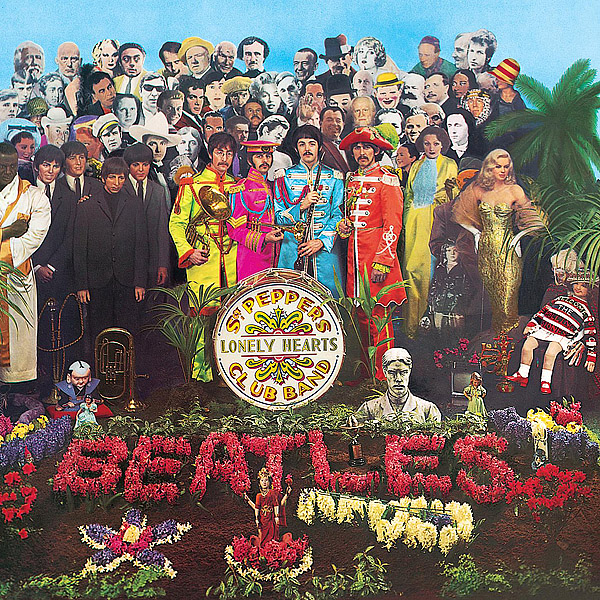















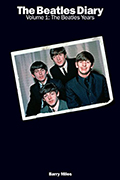
Contribute!
Have you spotted an error on the page? Do you want to suggest new content? Or do you simply want to leave a comment ? Please use the form below!